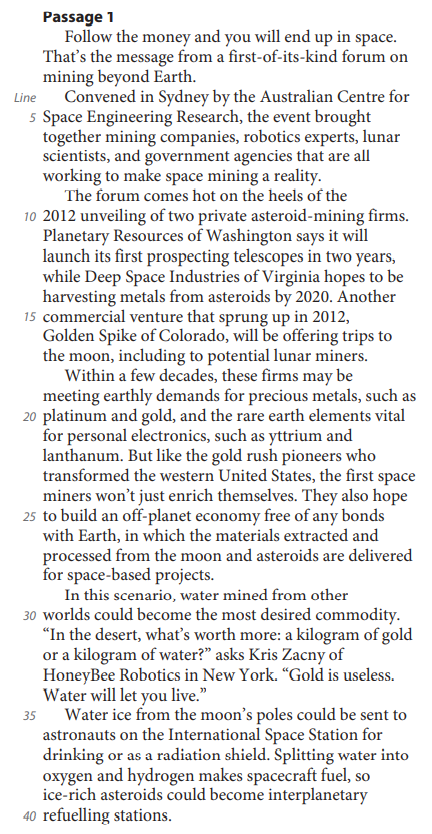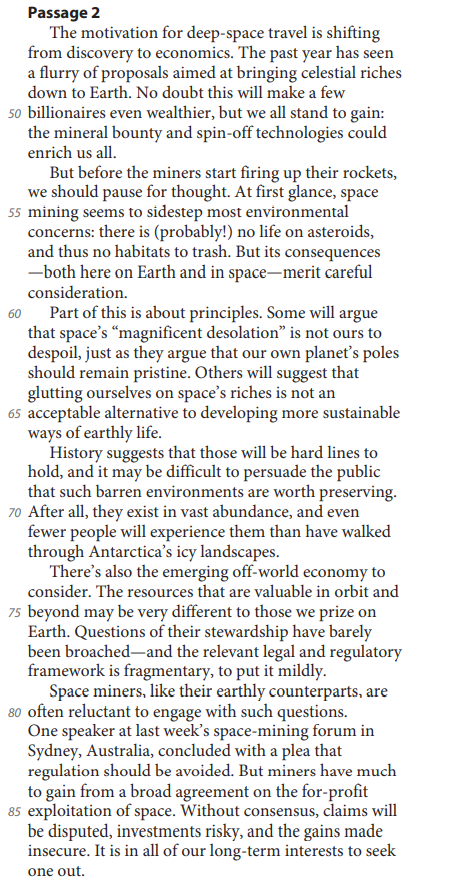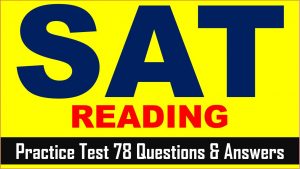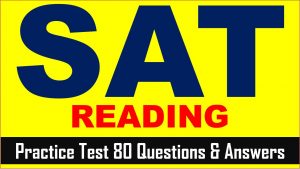SAT (Scholastic Assessment Test) is a standard test, used for taking admission to undergraduate programs of universities or colleges of the United States. SAT is developed and published by the College Board, an organization in the United States, administered by the Educational Testing Service. In this article of AKVTutorials, you will get SAT Practice Test 5 Answers | SAT 2024 Prep Online Tutor AMBiPi.
SAT Reading Practice Passage
Passage 1 is adapted from Michael Slezak, “Space Mining: The Next Gold Rush?” ©2013 by New Scientist. Passage 2 is from the editors of New Scientist, “Taming the Final Frontier.” ©2013 by New Scientist.


SAT Reading Comprehension Practice Test Questions
SAT Practice Test 5 Question No 1
In lines 9-17, the author of Passage 1 mentions several companies primarily to
Option A: note the technological advances that make space mining possible.
Option B: provide evidence of the growing interest in space mining.
Option C: emphasize the large profits to be made from space mining.
Option D: highlight the diverse ways to carry out space mining operations.
SAT Practice Test 5 Answer No 1
Show/Hide Answer
Option B :
The author of Passage 1 identifies specific companies such as the “Planetary Resources of Washington,” “Deep Space Industries of Virginia,” and “Golden Spike of Colorado” to support his earlier assertion that there are many interested groups “working to make space mining a reality” (line 8).
Choices A, C, and D are incorrect because the author of Passage 1 does not mention these companies to profile the technological advances in space mining, the profit margins from space mining, or the diverse approaches to space mining.
SAT Practice Test 5 Question No 2
The author of Passage 1 indicates that space mining could have which positive effect?
Option A: It could yield materials important to Earth’s economy.
Option B: It could raise the value of some precious metals on Earth.
Option C: It could create unanticipated technological innovations.
Option D: It could change scientists’ understanding of space resources.
SAT Practice Test 5 Answer No 2
Show/Hide Answer
Option A :
The author of Passage 1 explicitly states that one benefit to space mining is access to precious metals and earth elements: “within a few decades, [space mining] may be meeting earthly demands for precious metals, such as platinum and gold, and the rare earth elements vital for personal electronics, such as yttrium and lanthanum” (lines 18-22).
Choice B is incorrect because Passage 1 does not suggest that precious metals extracted from space may make metals more valuable on Earth. Choice C and Choice D are incorrect because Passage 1 never mentions how space mining could create unanticipated technological innovations or change scientists’ understanding of space resources.
SAT Practice Test 5 Question No 3
Which choice provides the best evidence for the answer to the previous question?
Option A: Lines 18-22 (“Within… lanthanum”)
Option B: Lines 24-28 (“They… projects”)
Option C: Lines 29-30 (“In this… commodity”)
Option D: Lines 41-44 (“Companies… machinery”)
SAT Practice Test 5 Answer No 3
Show/Hide Answer
Option A :
Lines 18-22 suggest that space mining may help meet “earthly demands for precious metals . . . and the rare earth elements vital for personal electronics.” In this statement, the author is stating materials (“metals,” “earth elements”) that may be gathered as a result of space mining, and that these materials may be important to Earth’s economy.
Choices B, C, and D do not provide the best evidence for the answer to the previous question. Choice B is incorrect because lines 24-28 focus on an “off-planet economy” but never address the positive effects of space mining. Choice C is incorrect because lines 29-30 suggest the relative value of water found in space. Choice D is incorrect because lines 41-44 state that space mining companies hope to find specific resources in lunar soil and asteroids but do not address how these resources are important to Earth’s economy.
SAT Practice Test 5 Question No 4
As used in line 19, “demands” most nearly means
Option A: offers.
Option B: claims.
Option C: inquiries.
Option D: desires.
SAT Practice Test 5 Answer No 4
Show/Hide Answer
Option D :
The author suggests in lines 19-22 that space mining may meet “earthly demands for precious metals, such as platinum and gold, and the rare earth elements vital for personal electronics.” In this sentence, “earthly demands” suggest that people want, or desire, these precious metals, and rare earth elements.
Choices A, B, and C are incorrect because in this context “demands” do not mean offers, claims, or inquiries.
SAT Practice Test 5 Question No 5
What function does the discussion of water in lines 35-40 serve in Passage 1?
Option A: It continues an extended comparison that begins in the previous paragraph.
Option B: It provides an unexpected answer to a question raised in the previous paragraph.
Option C: It offers hypothetical examples supporting a claim made in the previous paragraph.
Option D: It examines possible outcomes of a proposal put forth in the previous paragraph.
SAT Practice Test 5 Answer No 5
Show/Hide Answer
Option C :
Lines 29-30 introduce the idea that water mined in space may be very valuable: “water mined from other worlds could become the most desired commodity.” Lines 35-40 support this assertion by suggesting how mined space water could be used “for drinking or as a radiation shield” (lines 36-37) or to make “spacecraft fuel” (line 38).
Choice A is incorrect because the comparison in the previous paragraph (the relative value of gold and water to someone in the desert) is not expanded upon in lines 35-40. Choice B is incorrect because the question asked in the previous paragraph is also answered in that paragraph. Choice D is incorrect because no specific proposals are made in the previous paragraph; rather, an assertion is made and a question is posed.
SAT Practice Test 5 Question No 6
The central claim of Passage 2 is that space mining has positive potential but
Option A: it will end up encouraging humanity’s reckless treatment of the environment.
Option B: its effects should be thoughtfully considered before it becomes a reality.
Option C: such potential may not include replenishing key resources that are disappearing on Earth.
Option D: experts disagree about the commercial viability of the discoveries it could yield.
SAT Practice Test 5 Answer No 6
Show/Hide Answer
Option B :
The author of Passage 2 recognizes that space mining may prove beneficial to humanity, stating that “we all stand to gain: the mineral bounty and spin-off technologies could enrich us all” (lines 50-52). The author also repeatedly mentions that space mining should be carefully considered before it is implemented: “But before the miners start firing up their rockets, we should pause for thought” (lines 53-54); “But [space mining’s] consequences—both here on Earth and in space—merit careful consideration” (lines 57-59).
Choice A is incorrect because the author of Passage 2 concedes that “space mining seems to sidestep most environmental concerns” (lines 55-56) but does not imply that space mining will recklessly harm the environment, either on Earth or in space. Choice C is incorrect because the author of Passage 2 does not address any key resources that may be disappearing on Earth. Choice D is incorrect because the author of Passage 2 admits that “resources that are valuable in orbit and beyond may be very different to those we prize on Earth” (lines 74-76) but does not mention any disagreement about the commercial viabilities of space mining discoveries.
SAT Practice Test 5 Question No 7
As used in line 68, “hold” most nearly means
Option A: maintain.
Option B: grip.
Option C: restrain.
Option D: withstand.
SAT Practice Test 5 Answer No 7
Show/Hide Answer
Option A :
In lines 60-66, the author presents some environmental arguments against space mining: “[space] is not ours to despoil” and we should not “[glut] ourselves on space’s riches.” The author then suggests that these environmental arguments will be hard to “hold,” or maintain when faced with the possible monetary rewards of space mining: “History suggests that those will be hard lines to hold . . .” (line 68).
Choices B, C, and D are incorrect because in this context, “hold” does not mean grip, restrain, or withstand.
SAT Practice Test 5 Question No 8
Which statement best describes the relationship between the passages?
Option A: Passage 2 refutes the central claim advanced in Passage 1.
Option B: Passage 2 illustrates the phenomenon described in more general terms in Passage 1.
Option C: Passage 2 argues against the practicality of the proposals put forth in Passage 1.
Option D: Passage 2 expresses reservations about developments discussed in Passage 1.
SAT Practice Test 5 Answer No 8
Show/Hide Answer
Option B :
The author of Passage 1 is excited about the possibilities of space mining and how it can yield valuable materials, such as metals and elements (lines 19-20 and lines 41-42), water ice (line 35), and space dirt (line 44). The author of Passage 2, on the other hand, recognizes the possible benefits of space mining but also states that space mining should be thoughtfully considered before being implemented. Therefore, the author of Passage 2 expresses some concerns about a concept discussed in Passage 1.
Choice A is incorrect because the author of Passage 2 does not refute the central claim of Passage 1; both authors agree there are possible benefits to space mining. Choice B is incorrect because the author of Passage 1 does not describe space mining in more general terms than does the author of Passage 2. Choice C is incorrect because the author of Passage 2 is not suggesting that the space mining proposals stated in Passage 1 are impractical.
SAT Practice Test 5 Question No 9
The author of Passage 2 would most likely respond to the discussion of the future of space mining in lines 18-28, Passage 1, by claiming that such a future
Option A: is inconsistent with the sustainable use of space resources.
Option B: will be difficult to bring about in the absence of regulations.
Option C: cannot be attained without technologies that do not yet exist.
Option D: seems certain to affect Earth’s economy negatively.
SAT Practice Test 5 Answer No 9
Show/Hide Answer
Option B :
In lines 18-28, the author of Passage 1 describes many of the possible economic benefits of space mining, including the building of “an off-planet economy” (line 25). The author of Passage 2 warns that there may be ramifications to implementing space mining and building an “emerging off-world economy” (line 73) without regulation: “But miners have much to gain from a broad agreement on the for-profit exploitation of space. Without consensus, claims will be disputed, investments risky, and the gains made insecure” (lines 83-87).
Choices A, C, and D are incorrect because the author of Passage 2 does not suggest that the benefits to space mining mentioned in lines 18 28 of Passage 1 are unsustainable, unachievable, or will negatively affect Earth’s economy. Rather, the author recognizes the benefits of space mining but advocates for the development of regulation procedures.
SAT Practice Test 5 Question No 10
Which choice provides the best evidence for the answer to the previous question?
Option A: Lines 60-63 (“Some… pristine”)
Option B: Lines 74-76 (“The resources… Earth”)
Option C: Lines 81-83 (“One… avoided”)
Option D: Lines 85-87 (“Without… insecure”)
SAT Practice Test 5 Answer No 10
Show/Hide Answer
Option D :
In lines 85-87, the author of Passage 2 states that the future of space mining will prove difficult without regulations because “claims will be disputed, investments risky, and the gains made insecure.
Choices A, B, and C are incorrect because they do not provide the best evidence for the answer to the previous question. Choice A is incorrect because lines 60-63 present some environmental concerns toward space mining. Choice B is incorrect because lines 74-76 focus on how space mining may discover valuable resources that are different from the ones found on Earth. Choice C is incorrect because lines 81-83 simply describe one person’s objections to the regulation of the space mining industry.


